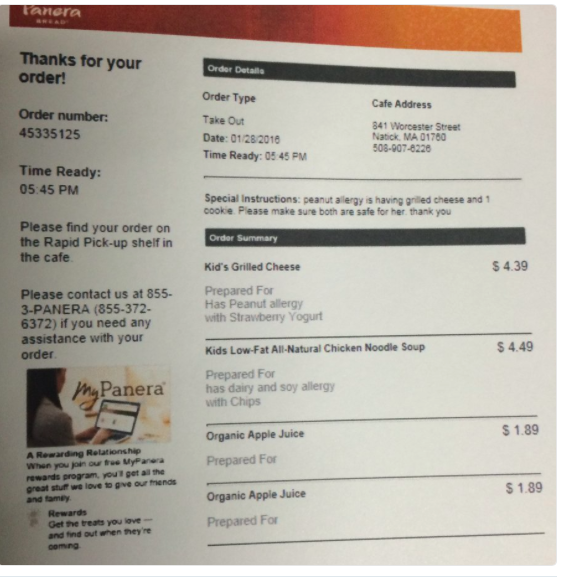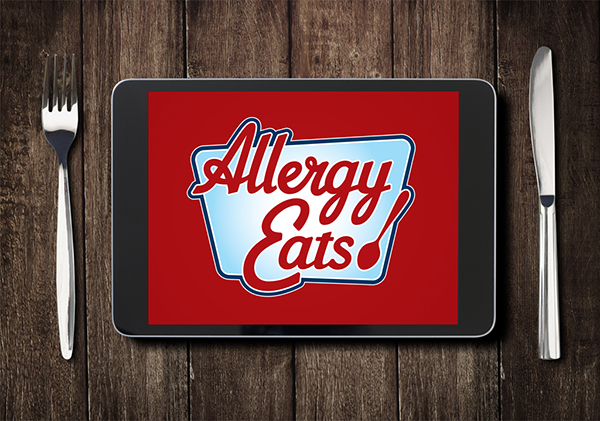Panera Disaster: The Food Allergy Lawsuit & What Went Wrong
Panera Disaster: The Food Allergy Lawsuit & What Went Wrong
If you follow food allergy news, then you’ve likely seen the story that made headlines last week in Boston and beyond: a grilled cheese sandwich made with peanut butter by a Panera Bread store in Natick, MA and served to a young girl with a (twice) disclosed peanut allergy. The family of the girl is now suing Panera Bread for negligence. While the issue of responsibility may seem cut and dry, there are some interesting facets of this story that warrant closer inspection.
For those who haven’t read about the case, here are some of the facts as they’ve been reported by the Boston Globe and others. (AllergyEats has not interviewed any of the parties involved.) A Natick, MA family placed an online takeout order with their local Panera Bread franchisee; part of the order included grilled cheese for their then 5-year-old daughter. The girl’s mother noted, in two different places on the online form, that the grilled cheese was for someone with a peanut allergy. After the order was picked up and brought home, the little girl bit into the sandwich and tasted peanut butter. Upon inspection, the girl’s father saw that there were about two teaspoons of peanut butter on the grilled cheese sandwich.

Grilled Cheese made with peanut butter (as seen in the Boston Globe)
The girl initially didn’t show “serious symptoms,” so the parents called their family pediatrician who suggested the child be given Benadryl. After she later vomited, the young girl’s concerned parents took her to a local hospital, where, just as she was preparing to be discharged, she broke out in hives all over her body. She was given epinephrine and kept overnight. Subsequently, when the girl’s father later called the restaurant to discuss what had occurred, a restaurant manager claimed that a “language issue” was the cause of the problem.
Making this story even more interesting is that it is alleged that a similar incident happened at a Panera Bread owned by the same franchisee in a neighboring town (Wayland, MA) less than a month later. This situation was supposedly posted on a popular Facebook food allergy support group page by the mother of the food-allergic child involved, but was eventually removed. The family involved in that incident declined to be part of this lawsuit. Regardless, given the unlikelihood that two grilled cheese sandwiches would be made with peanut butter within a month of each other and in nearby locations – both served to peanut-allergic customers – questions are being raised by the food allergy community and being asked by the Boston Globe: “Have these been deliberate actions?” Many are saying they have to be, with the logic that putting peanut butter on grilled cheese is unusual and suspect. Others are taking the opposite opinion, unwilling to believe that people would conspire like that. As for me, I’ll say what I believe is the truth: “We don’t know.” Everyone is certainly entitled to his or her opinion, but personally, I am unwilling to make this leap without evidence. Assuming the lawsuit moves forward, we may learn more. Either way, the fact that this happened twice is, well, doubly disturbing!
So what is going on? Is Panera unique or can this happen anywhere? Is it even safe to dine out with food allergies at all?
The quick answer is that it is just as “safe” for a food-allergic individual to dine out now as it was a week ago… and safer than a year ago and even more so versus five years ago. Yet, we will never get to a place where we can expect “allergy-safe” dining (which is why AllergyEats always says “allergy-friendly”) because there can never be a guarantee of safety anywhere. Humans run the restaurants and unfortunately humans make mistakes. When those of us with food allergies dine out, there is naturally some level of risk involved, so it’s necessary to take precautions in order to be as safe as we can possibly be.
With that said, why do most of us dine out successfully (i.e. with no reaction) almost all of the time? The reason is that, for a failure to occur, MULTIPLE steps in the “food allergy dance” we have with the restaurant must break down.
Let’s look at how these steps work when everything is done right.
- First, the food-allergic individual enters the restaurant, always carrying epinephrine!
- Then, the individual discloses his or her allergy to a staff member, keeping an eye open for any signs of discomfort from the staff member about serving an individual with food allergies.
- If all is as it should be, that staff member, as well as all other staff in the restaurant, has previously been trained in what to do when a food-allergic guest enters, so he or she puts in motion whatever communications protocol that restaurant has in place.
- At the time of ordering, the restaurant is able to share with the guest what ingredients are in the various menu items (even if consultation with the kitchen or labels is needed) and where there might be risk of cross-contact.
- After the food-allergic patron orders, that order is passed to the kitchen with a visual and verbal notification of the diner’s food allergies, again in keeping with the restaurant’s standard protocols.
- The kitchen then follows their practiced procedures on how to cook that diner’s meal, avoiding contamination from any of the individual’s allergens.
- When finished, the chef flags the plate as the one for the food-allergic guest and the front-of-the-house staff delivers it specifically to the guest.
- The guest then inspects the meal for any easy visual signs of a mistake or even less obvious signs that they should double-check what was served.
- And if everything works as it should – as it does most of the time – the food-allergic individual enjoys his or her meal with no problem!
With all of that to get right, how is it that so FEW diners end up in the ER?
The answer is that there are checks and balances among the many steps listed above that allow mistakes to be caught most of the time before a dangerous situation occurs. In reality, MULTIPLE steps of this process need to break down for a potentially tragic error!
I’ll use my own family’s experiences as an example. The only time we ever had a food-allergy accident at a restaurant, it was actually our fault for mis-ordering. (Staff aren’t mind readers. If you don’t disclose your allergies clearly, then that is one step of the process that could cause a serious problem by itself.) However, we’ve been SERVED the wrong food many, many times. On most of those occasions, we caught the problem ourselves by inspecting the food (even asking questions about something that “seemed” wrong). So where one step went wrong in the above scenario, another step caught the problem. Similarly, we had a waitress catch TWO mistakes by the chef in one of our meals (at Disney World, no less), again showing the checks and balances in this process and how they prevent catastrophes. Some restaurants make it easy by delivering food-allergic diners’ meals on different colored or different shaped plates. Thus, if the food-allergic diner doesn’t get that special plate, they can catch an error. And at the end of the day, the most important way to prevent a fatal reaction is by adhering to Step 1 – always carry your epinephrine!
What broke down in the Panera case?
Well, it seems… A LOT. I don’t like assigning blame; I’d rather analyze what went wrong and determine how it can be avoided in the future. Having spent the last six years reading thousands of reviews from food-allergic diners about places that can – and can’t – accommodate, coupled with countless conversations with restaurateurs and food-allergic patrons, here’s my perspective on what went wrong in the Panera case:
- While many of us – including me – order food online, we have to be aware that it involves an extra layer of risk. Given that we are not in front of the person we are entrusting with our order, it’s not as easy to assess if they truly understand the extent of our dietary restrictions. Body language and a confident exchange of questions and answers tend to be key indicators as to whether someone “gets it” or not, but of course we lose those cues when ordering online. Further, almost all online ordering systems do not have a specific place to signify food allergies, so people need to enter them in the Special Instructions section, which may not flag a ticket as prominently as it should for a food-allergic guest. (This is why AllergyEats hasn’t yet offered online ordering on its app or website.) So “Mistake #1,” which should really be titled “Elevated Risk #1,” was the family ordering online.

Panera order ticket with food allergy instructions (as seen on BostonGlobe.com)
- In fact, “Mistake #1” REALLY should have been choosing to eat at Panera Bread in the first place! One of AllergyEats’ Dining Tips is to “do research in advance of dining out”. If the family had done this, they may have realized that Panera has a bad reputation for their inability to properly accommodate food-allergic guests, earning them a very low 3.0 chain-wide AllergyEats allergy-friendliness rating overall, and a slightly higher 3.05 for those with a peanut allergy. Moreover, there have been extensive social media discussions citing numerous negative experiences at Panera Bread restaurants. It is clear that Panera’s management – unlike many other restaurants and chains – does NOT make accommodating food-allergic guests a priority. With so many other choices, it would have been advisable to get a better dining recommendation.
- To its credit, Panera does have food allergy disclaimers on their website saying “Many of our products contain or may come into contact with common allergens…” and “Please note that we cannot guarantee that any of our menu items are free of allergens because we use shared equipment and handle common allergens throughout our supply chain and bakery-café.” (They have signs to this effect in their stores as well, though that doesn’t apply here since it was a take-out order.) However, I challenge everyone to go to Panera’s home page and try to find the Allergen & Nutrition page that shares this information. Unlike other websites where it is easy to find, trying to find this page is like trying to navigate a maze. And if a visitor to the website doesn’t KNOW it’s there, the likely assumption will be that they have no allergy information whatsoever.
- If the manager of the Natick restaurant is being truthful that there was a “language issue” that caused the problem, I think the next breakdown at the restaurant is obvious. Regardless of ethnicity, background, or any other factors that could cause difficulty in communications and understanding, it is the restaurant’s responsibility to insure that a disclosed food allergy condition is properly communicated, along with the meal, from the front-of-the-house to the kitchen and back again.
- As already noted, the Panera Bread chain clearly does not have the training or policies & procedures in place to confidently manage a food allergy order and keep it free from cross-contamination. That much is clear from their public statements and in their diner reviews on AllergyEats. Even worse, however, is the fact that the kitchen put a significant amount of peanut butter on a grilled cheese sandwich – clearly a deliberate decision, even if it wasn’t a malicious one. The bottom line is that a lack of training and procedures & protocols can lead to dangerous situations.
- Another missed opportunity to catch the error was in not double-checking the order upon receiving it (to the extent it was possible). As mentioned earlier, I – and I’m sure most of you – have been served incorrect meals many times, but caught them before a bite was taken. In my 18 years with food-allergic children, I can say this has happened to us dozens of times. I do confess though to having missed one by not inspecting a sub sandwich served to one of my sons with a dairy allergy. Inside? Cheese. I can see where inspecting grilled cheese may be difficult given that the cheese keeps the bread together, just as inspecting certain other foods may be nearly impossible as ingredients aren’t necessarily so prominent, but however and whenever possible, the food-allergic patron needs to inspect his or her food for any signs of food allergens. Or, at the very least, have a brief conversation with the wait staff one last time to confirm that your order is, in fact, your allergen-free meal. That is harder, yet certainly not impossible, to do when picking up a take-out order.
- Finally, some have criticized the family for not immediately giving epinephrine – viewing that as yet another mistake in this story. However, with no significant signs of distress, many of us would likely have chosen a route similar to the one they chose: Benadryl. (Not to mention that the family received this advice from their trusted pediatrician.) Unfortunately, these types of delayed-onset reactions are tricky and scary – I unfortunately have first-hand experience. Having epinephrine on hand was key, as it could’ve saved their daughter’s life if anaphylactic progression took hold quickly. The family handled it well by knowing when it was time for the ER and letting the professionals take over.
What can we learn from the Panera case?
The bottom line is that there were a multitude of steps that broke down in this process. And generally, tragic mistakes only occur when there are MULTIPLE breakdowns, usually by both parties. OUR responsibility, as food-allergic diners, is to bring epinephrine with us everywhere, always disclose allergies (don’t get lazy, make assumptions or trust allergen charts alone as they can’t prevent cross-contamination), and inspect our meal to the best of our ability. I also believe that choosing a more allergy-friendly restaurant, as determined by feedback from the community, will lessen (though not eliminate) risk.
I said it earlier – I’m not a blamer. That’s not to say there isn’t blame – I’d just rather focus on what went wrong and how everyone can do their part to avoid potential tragedies in the future.
My heart is with this little girl as I have seen so many children develop the kind of food anxiety her parents say she is now experiencing. So if we want to blame, let’s at least pause first to be thankful that she’s alive and think about the struggles she may face.
I know there are a wide variety of opinions on this and many may think I’m not hard enough on one party or another. I encourage your comments, opinions, and criticisms below.


Comments